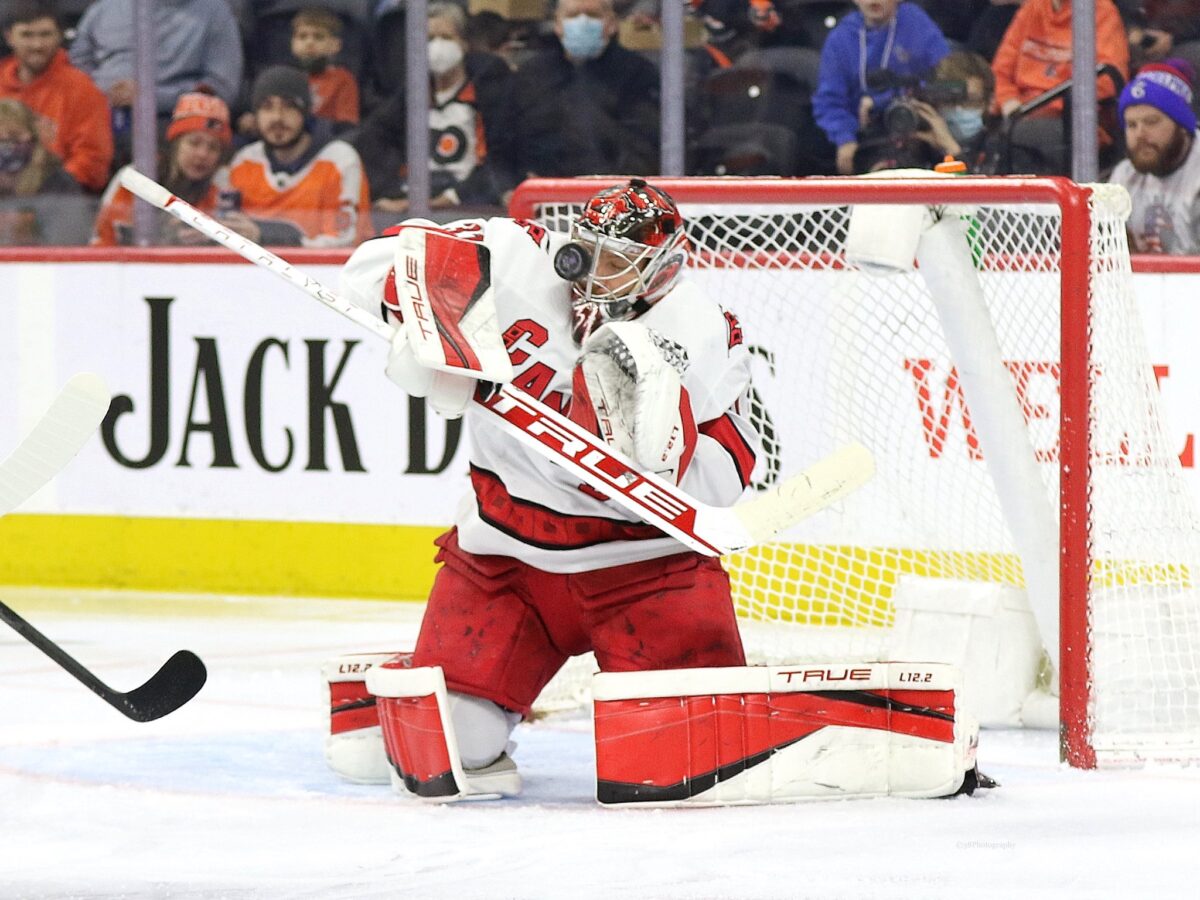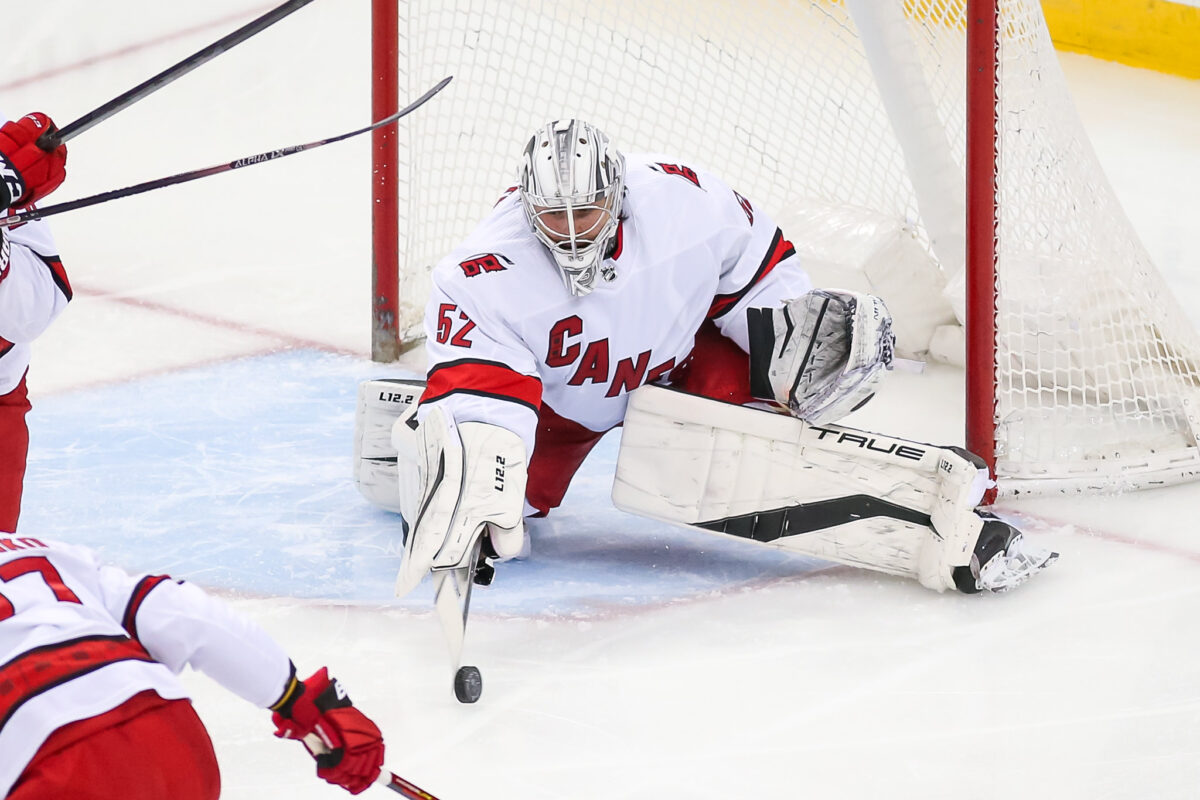The Carolina Hurricanes, who currently sit second in the NHL’s Metropolitan Division, are off to a good start to the season. But there may be a bit of concern in the blue paint with the goaltending duo of Frederik Andersen and Antti Raanta. In a year that both goaltenders are pending unrestricted free agents (UFA), they are not playing to the standard that many had hoped.
Goaltending is the most important position on an NHL team. The last line of defense, and the one player who can make or break any game, or even an entire season, needless to say, is a valuable role. For a team seeking to contend for the Stanley Cup, questions in goal can get a lot of conversations and concern started amongst fans. With that said, it is still very early, and their play can get better very quickly.
Hurricanes’ Goaltending Performances
Through the teams’ first 12 games, Andersen has eight starts and a record of 5-3-0, with a save percentage (SV%) of 0.891 and a goals-against average (GAA) of 2.72. This is not good enough for the starting goaltender. The team has played very well in front of him, resulting in the positive record, but Andersen hasn’t been making all of the saves the team is expecting him to make.
Throughout the last five games he played, Andersen has only had one game with an SV% of .900, with the rest being in the .800s. The Hurricanes have a great defensive system, and while there are certainly some mistakes on the defensive end, the team allows just over 25 shots against per game with Andersen in net, so it’s not like he is getting peppered every night.

On a positive note, Andersen started the season with an SV% of .969 and .957 in his first two games, and there have been signs of positivity in his game. He’s had some great periods, bailing out the Hurricanes on multiple occasions and making some big saves. Prior to the game against the Maple Leafs, per TopDownHockey, Andersen had a goals saved above expected per 60 minutes (GSAx/60) of plus-0.4, meaning he is making all of the saves he should be making each game, and even a little bit more. (his GSAx/60 of +0.4 ranks ninth among all starting goaltenders).
Related: NHL’s Top 10 Goalies for 2022-23
Raanta, who is serving as the backup goaltender, has been doing better, but he still isn’t where people expected. With a .904 SV%, he has to start making some more saves. Like Andersen, the GAA is low enough, with Raanta’s being 2.42, but that is a testament to how structured Rod Brind’Amour keeps his team. Raanta does have a great record in his four games, holding a 3-0-1 record on the season. While many will look at these numbers and say that it is okay because the team is still winning, it would be nice for the goaltenders to show the capability of stealing a few games for the rest of the team.
Not Time For Concern, Yet
Last season, Andersen finished fourth in Vezina Trophy voting as the NHL’s top goaltender. He was fantastic. I don’t think too many people expected back-to-back Vezina contention seasons from Andersen, but the expectation is that he can still come in around a .915 SV%. Last season, he started his year with eight straight wins, and only two of those games ended with an SV% below .950. That is almost unrepeatable. Goaltenders get off to slow starts all of the time, and it is easy to have short-term memory about how dominant he was just last year.
The issue with Andersen’s tenure in Toronto was that he was portrayed as inconsistent. Nobody would be surprised to see him go from the start he has had this year to two shutouts in his next three games. The team is playing well enough in front of him that they can afford to have some hiccups in goal. Obviously, these hiccups can not be an ongoing issue, and until we have reason to re-visit this conversation, I don’t think anybody should be concerned.
When it comes to Raanta, who is still yet to lose in regulation, there can definitely be some more faith at this moment. He has the teams’ trust, as well as the fans’ trust. Despite the low SV%, there shouldn’t be any worry with him, as he is able to step into any role the team needs. If management feels that Andersen needs a break to reset, Raanta can be the acting starter. If Andersen is on a hot streak, Raanta can sit until needed. The versatile backup is exactly what the Hurricanes should be happy to have.
Hurricanes Have Big Decisions to Make in Off-Season
Where the Hurricanes, as well as their fans, could be concerned is what will happen this upcoming off-season. It is far too early to make any predictions on what may happen, but both goaltenders are pending UFAs. Andersen, who signed a two-year, $4.5 million contract, will likely be looking for a raise if he can even come close to replicating his performance last year. I think it is a no-brainer to be looking at bringing Andersen back, as he has proven to be able to be dominant. The Hurricanes are currently battling to get back over the second-round hurdle and advance to the conference final for the first time since 2019. If he can help them get back there, there is no question at all about bringing him back.
If Raanta and the team can agree on a deal with a low enough cap hit, it would be a wise decision to bring him back too. As I said above, the versatility of his role is very valuable and should be treated as an important part of the tandem. The Hurricanes will have a big decision to make here, though. Pyotr Kochetkov is knocking on the door for an NHL job, and with Raanta’s contract expiring, it may be a perfect time for that transition to be made.

Both Andersen and Raanta have had issues staying healthy, which gave Kochetkov an opportunity to play seven games last season, four of which were in the playoffs. In the American Hockey League this season, Kochetkov has been serviceable and will be the first call-up if there are any injuries in net.
The current duo, while both playing a bit under par and on expiring contracts, sounds exactly like a reason to be concerned, it shouldn’t be in this case. The team is winning, the goalies have a low GAA, and the team does seem to have lots of confidence in front of both goaltenders. Both in contract years, they will be doing everything they can to maximize their next deal. The SV% and the GSAx/60 don’t match up, but the SV% will rise. Everything will be just fine.